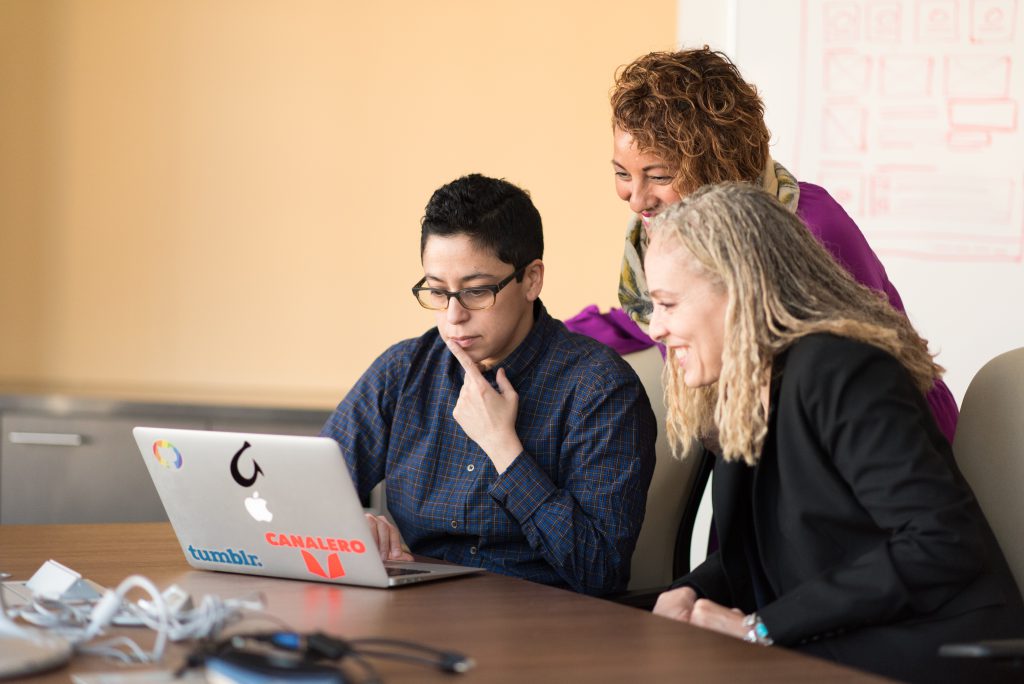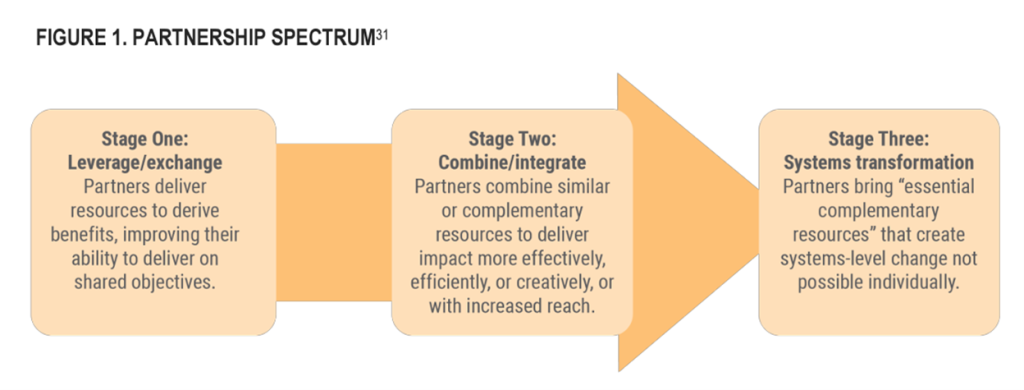We Can’t Go It Alone - Forging Business and Industry Partnerships to Transform Higher Education
Published by: WCET | 1/26/2023
Tags: Distance Education, Higher Education Trends, Online Learning, Student Success, Workforce/Employment
Published by: WCET | 1/26/2023
Tags: Distance Education, Higher Education Trends, Online Learning, Student Success, Workforce/Employment
Today we welcome back Kara Monroe, friend of WCET and President and Founder, Monarch Strategies, to continue her discussion of the future of higher education. Specifically, today’s post focuses on institution and industry partnerships and how institutional leadership and staff can ensure that these partnerships flourish and, ultimately, help our students be more successful.
Take it away, Kara!
Enjoy the read,
Lindsey Downs, WCET
In my previous post this month, I talked about the need for higher education in creating a vital American economic future. Even as our institutional enrollments decline, employers are demanding more workers with new skills and abilities – two trends that appear as if they will continue at least for the near future of this current decade. In that post, I suggested three things that we in higher education must do:
In this post, we’re going to dig into the specifics of one way you might bring each of these three things to life as we talk about forming deep partnerships with the businesses and industries that you serve.

When I visit colleges and universities around the country, I often ask Presidents and Provosts who their primary employers are. It is a sure sign of trouble when neither of these individuals can name the top two or three employers of their students.
In order to build strong workforce partnerships, you must first know who it is that your students find their way to after graduation. While many business engagements with colleges and universities begin as alumni relationships or sitting across the table in an economic development trip to lure a new business to a community these are not the stuff true partnership is made of.
Institutions that continue to rely on only that final graduate survey to identify employers are not doing what is hard. These surveys often yield results of only 10 – 20% and with results coming from only our best and brightest students. We must leverage student relationships with their program faculty to gather better data and even mining publicly available data to help us identify where students are working.
As you get a better understanding of the business and industry community your institution serves you must also consider the other organizations that SHOULD be on that list. Given the programs and services offered at your institution, what organizations should be on your list of businesses and industries? I do not, in any way, intend for this to be an aspirational list. This should be a factual list of the organizations that need your students in order to thrive. Far too many educational leaders are obsessed with building their own ego because they can talk about the number of Fortune 500’s students are employed at and similar statements. Those are NOT the organizations that need your help in your local geographic area. Research conducted in 2009 found that students travel a median distance of just 94 miles to go to college. While many factors influence how far a student may be willing or able to travel to attend college – and certainly the availability of online education may drive significant change here in the future – you should begin identifying those businesses your institution should be serving close to home and work outwards from there.
Once you have both lists – compare them. This will help you identify where to begin in building new partnerships.
Once you’ve identified the partnerships you should have it is time to begin to assess their strength. This step is far too often skipped in higher education institutions. Yet, it is critical to help prioritize how individuals in the institution spend their time – something often lacking or at least overlooked as C-level leaders simply make agreements about institutional time and resources without necessarily weighing the cost of those agreements against any set of benchmarks.
The best set of assessment criteria for partnerships that I’ve come across comes from the US AID Momentum Report. This report, while primarily focused on the workings of governments and NGOs, summarizes work that is similar to much of what we undertake in higher education. The language to describe partners might vary a bit but the principles are highly generalizable. If you’re serious about undertaking this work, the report and many of the links out of the report are worth your time to read but for the purposes of this post, I’ll summarize the factors identified as critical to the strength of a partnership.
First, USAID points to the Sustainable Development Goals Handbook’s levels of partnership:

So, begin here – identify the state for each of your partnerships. I’ll dig more deeply into what each of these stages tell us about overall partnership health in the companion piece to this post available to WCET members in wcetMIX (coming soon!).
Next, you can undertake a partnership assessment that is more thorough. The Momentum Report includes several key points you may wish to assess along with a survey of assessment instruments in the field. In the WCET Member companion piece, I’ve provided a rubric that has been valuable for me in assessing partnerships and a look at how to conduct that assessment without it being burdensome.
Partnership strength often rests on the shoulders of the individuals engaged in the partnership. As a former C-level institutional leader, I know full well that I often asked already overcommitted individuals to take on an even higher level of responsibility and commitment without offering them any real way to balance the workload. So, in this specific question, I’m calling on all of us to do better than I did.
For many institutions this can start with a simple survey of faculty and staff focused on two sets of questions:
And, please, don’t just send out a survey with these questions in it and not expect extreme pushback. This type of inquiry MUST be grounded in a trust ethic that, if not present at your institution, implies work you must do before you ever start to assess your external partnership capacity. Start with your internal partnership capacity and make sure that everyone in your institution has opportunities to be heard, to take risks, and to engage in ways that allow them to showcase their knowledge, skills, and abilities.
In a high trust organization these questions can enlighten inroads to organizations that you had no idea you already had such deep relationships with. An institution in a “factory town” that I visited several years ago was struggling to help that factory see its value until they did a survey like this one and realized that more than 80% of their employees had a spouse or child employed in the factory. Taking this one piece of data to the manufacturer’s leadership team opened up new conversations that had never before been possible. It seems like a small and insignificant fact, but it launched a massive partnership.
I’m going to close this piece with the hardest of the questions I have for you – what must we stop doing to make room for what we must start? I have found that nearly everyone in a higher education institution is willing to tell you what someone else should stop doing (that requires work on their part for it to be successful) but are far less likely to list anything that they should stop doing. The partner of this is focusing only on those things to stop doing that would require massive shifts in government and accreditor guidelines rather than focusing on what is actually happening.

Don’t dismiss these things that require massive government or accreditor shifts. You still need to work diligently to chip away at these – and that is largely the role of Directors and above – but you must NOT let these sideline what can actually be stopped within the institution. I also urge you not to focus only on those items that point to a need for process improvement. While those items will inevitably come out in these types of exercises, they will not lead to the type of real time freeing change that you’re seeking. They are valuable, but not the highest value possible from this exercise.
So, you must identify instances where there are things that – oftentimes – rest in individuals’ whole reasons for having a job. A campus under my purview was drowning in “schedule change.” emails. When I dug into the issue with them, we realized that one administrative assistant was sending out an average of 40 emails a day during peak registration periods. For a community college on a predominantly eight week schedule, that really felt like it was all the time. Several of her other duties had been taken over by automation and process improvement and to make sure she appeared busy and essential to everyone around her she started “monitoring” the schedule to “help” program chairs know when to add new sections, close sections, etc. The only problem was it was adding to the workload rather than decreasing it. And this person was smart and talented – her skills could be used in many better ways. When her supervisor finally had a real conversation with her about her goals, he learned she wanted to be an academic advisor but couldn’t afford to go to college to get her bachelor’s degree. She wasn’t aware of the HR policy for tuition reimbursement and that essentially she could earn that degree for almost nothing out of pocket. That simple conversation put her on a new life path that she found far more fulfilling and improved institutional capacity. Are they all this easy to solve or this positive in outcome? Not at all. However, these are the types of things you must dig into and really suss out if you’re going to figure out what you must stop doing.

These steps create a framework on which you can build and sustain partnerships. I’ll go into even more depth on many of these pieces as well as steps specific to building partnerships in the companion piece available to WCET members inside of wcetMIX. We’ll also discuss these together – learning from others what has worked and what hasn’t – in this month’s Closer Conversation on Jan 27, 2023 – also available to all WCET members.
President and Founder, Monarch Strategies LLC